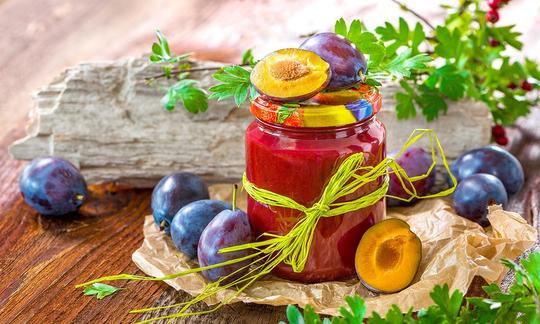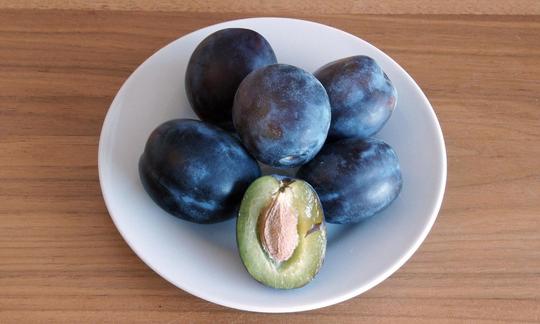The common plum can be eaten raw, cooked or dried. Plums have a lower water content than the closely related common plum.
Use in the kitchen:
Ripe plums ( Prunus domestica subsp. domestica) taste wonderful raw as a dessert, in fruit salad or in muesli. The plum (damson, quetsche, damson) has a sweet and sour taste and firmer flesh than the common plum. The juicy fruit is also very suitable for baking, as it loses very little juice.
Plum cakes made with yeast, shortcrust or shortcrust pastry are well known. They can also be made into compote, jam or ice cream. In Austria, plum or plum jam is called "Powidl", in Switzerland "Latwerge". To make this jam, very ripe plums are reduced without using any gelling agent. Depending on the sweetness, no sugar or much less sugar is used than in conventional jams.
As dried fruit, plums provide plenty of energy due to their high sugar content and taste particularly delicious due to their sour note. Another processing option is distillation to make fruit brandy (plum water). The stone comes off the flesh relatively easily, unlike plums. To do this, roll it between both hands with light pressure across the stone. 1
Plums can be combined well with oranges, apples, beans, shallots or nuts. Sweet plum dishes can be flavoured with vanilla, cinnamon or gingerbread spice, and savory dishes such as chutneys or sauces with ginger, garlic and onions.
| Not only vegans or vegetarians should read this: Vegans often eat unhealthily. Avoidable nutritional errors. |
Purchasing:
Plums are in season between July and October. The egg-shaped, blue to blue-black fruits can reach a length of up to 8 cm. The larger fruits are usually cultivated table fruit from plantation cultivation. Domestic plums are old, later-ripening, sometimes very productive varieties with small, aromatic fruits. They also thrive at high altitudes. Organically produced fruit has no pesticide residues and is therefore preferable. When buying, look for undamaged, firm fruit. Overripe plums are often prone to worm infestation.
Wild:
Wild specimens of the original cherry plum ( Prunus cerasifera) can be found in fruit-growing areas, in old orchards, on the edges of roads and forests and along streams. The origin is probably in the Balkans and in Asia Minor and Central Asia. The fruits of the cherry plum are spherical and, with a diameter of 2-3 cm, are comparable to mirabelles, i.e. much smaller than the well-known real plums. The fruits of the cherry plum are ripe in June or July and shine in yellow, red or blue-violet from the bush or tree. The flesh of ripe fruits tastes pleasantly sweet, the skin is usually very sour. 2
The second parent of Prunus domestica is the blackthorn ( Prunus spinosa) - see below under General Information. It is an important wild shrub for animals. The exact dates of origin are not known. Blackthorn seeds were found in Neolithic wetland settlements in Central Europe. Today, the blackthorn is native to Europe, the Middle East, the Caucasus and North Africa. The blackthorn fruits are ripe from September onwards and are usually harvested after the first frost. This means that the fruit breaks down a large proportion of the bitter-tasting and astringent tannins using enzymes. 3
Storage:
Plums ripen relatively quickly. You can enjoy fruits that are still too firm a few days later (store at room temperature). If the plums are already ripe when you buy them, process them quickly or eat them straight away. The fruit will stay fresh for a few days in the fridge. The whitish layer is only washed off shortly before consumption. This natural wax film prevents them from drying out too quickly. Plums can be easily frozen for later processing if they have been washed and pitted. However, they are no longer suitable for raw consumption after this.
Ingredients:
The plum contains less water and a little more sugar than the related noble plum. It contains minerals: potassium, magnesium, calcium and a little iron. Important vitamins are vitamin C, vitamin E and folate (folic acid). Plums also contain small amounts of B vitamins such as thiamine (B1), niacin (B3), riboflavin (B2), pyridoxine (B6). For more detailed information, please read the ingredient tables below the text.
Health aspects:
All plums, including damsons, are said to have a digestive effect. The plant fibers contain secondary plant substances such as pectin and cellulose. These substances swell in the intestines and stimulate digestion. In the case of constipation, the laxative and diuretic effect of plums is used to relieve the symptoms. With this digestive effect, regular consumption of plums, especially in dried form, can minimize the risk of colon cancer. 4
According to studies by Texas A&M University, extracts from plums are said to reduce the risk of breast cancer. The polyphenols and chlorogenic acid they contain are responsible for this. 5,6 The polyphenols in the dark-colored fruits include anthocyanins. Yellow plums (mirabelles, greengages) contain carotenoids. The anthocyanins are said to strengthen the immune system, protect against cardiovascular diseases and have an anti-inflammatory effect.
The fiber in the skin of plums, especially pectin, helps to lower cholesterol levels. Plums are also said to have positive effects on gout and liver problems. 7
Dangers / Intolerances:
People who are fructose intolerant should avoid eating plums. Ripe fruits in particular have a very high fructose content. In the case of intolerances, symptoms such as abdominal pain, nausea or diarrhea can occur. 7
Folk medicine:
The original use of plums in traditional European folk medicine as a laxative can now officially carry a health claim. For example, "Dried plums contribute to normal bowel function." 8
In Africa, the bark of the plum tree is used to treat benign prostatic hyperplasia (BPH), a positive enlargement of the prostate. Testosterone levels in men decrease with age, while estrogen levels remain the same. This creates an excess of estrogen, which slows down the natural cell death of prostate cells. Tests of this remedy at Panjab University in India showed not only a balancing effect between estrogen and the male hormone T, but also a positive effect against inflammation and free radicals. 9
Occurrence:
The plum ( Prunus domestica subsp. domestica) belongs to the cultivated plum ( Prunus domestica), whose origin is not clearly established. It is a typical stone fruit. It is believed to have originated near the Caucasus and the Caspian Sea. 14 It appeared in Roman texts in the 1st century AD. Alexander the Great probably became acquainted with plum species on military campaigns and introduced them to his homeland (Macedonia - the north of ancient Greece). 10 Today it is cultivated in Europe, West Asia, North America and North and South Africa. 11
Cultivation, harvest:
Plums need deep, easily warmed soil that holds water well but does not cause waterlogging. Depending on the location, a suitable rootstock is used (as a rootstock). The growth heights of grafted trees vary greatly. They rarely reach a height of up to 10 m. When buying a plum tree, look for self-fertile varieties. Annual pruning tailored to the variety ensures healthy plants for many years and a good yield. 12 The plum moth is a serious pest in plantation fruit cultivation. The caterpillars appear in two generations. Infected plums experience an emergency ripening and fall to the ground prematurely. They are then no longer edible. Infected fruit can often be recognized by a colorless resin droplet on the outer borehole. The pest overwinters as a pupa in the moss on tree trunks or in rotten wood on the ground. 13
Risk of confusion:
The difference between damson and plum is not always clear for many consumers. Plums can be recognized by their round shape with a clear seam through the pit. The color of the common plum ( Prunus domestica var. subrotunda) ranges from dark red to blue-black. Greengage plums ( Prunus domestica var. claudiana) are also plums, but differ significantly in their green-yellow color. The plum pit is rounder than that of the plum and is more difficult to separate from the flesh. Plums have less acid but contain more water, which is why they are less suitable for baking than the related plum. However, plums are excellent for sauces, chutneys, jam, puree, compote, juice or crumble.
General information:
The common plum ( Prunus domestica subsp. domestica) is a subspecies of the cultivated plum ( Prunus domestica) in the tribe of stone fruit plants (Amygdaleae) within the rose family (Rosaceae). The cultivated plum is probably a hybrid of the cherry plum ( Prunus cerasifera) and the blackthorn ( Prunus spinosa). 14,15
There are 7 subspecies of the (cultivated) plum 16 :
- Common plum, damson or plum (Austrian) ( Prunus domestica subsp. domestica)
- Mirabelle plum ( Prunus domestica subsp. syriaca)
- Creeping plum or oat plum ( Prunus domestica subsp. insitia)
- Ziparte or Zibarte ( Prunus domestica subsp. prisca)
- Half plum ( Prunus domestica subsp. intermedia)
- Spilling ( Prunus domestica subsp. pomariorum)
- Noble plum ( Prunus domestica subsp. italica). The noble plum is the commercially available plum and includes two groups of varieties: the dark true noble plum or noble round plum ( Prunus domestica var. subrotunda), often available in supermarkets, and the green-yellow greengage, Reine Claude, Ringlotte, Ringelotte or Ringlo ( Prunus domestica var. claudiana) 17, known in English as greengage.
There are over 100 different cultivated plum varieties in Central Europe. They differ mainly in size, flesh color and taste.
The wood of the plum tree is very hard and highly sought after due to its beautiful reddish-brown color. Carpenters use it to make high-quality furniture. 1
In Austria the name is written as Zwetschke, in Germany the regional names are Zwetsche or Quetsche. 1
Literature / Sources:
- Wikipedia Common Plum.
- Wikipedia cherry plum.
- Schermer B. The great Teubner kitchen practice. Gräfe and Unzer. 2008.
- Schattenberg P. Dried plums can reduce risk of colon cancer, research shows. Texas A&M AgriLife Communications. ScienceDaily. September 2015.
- Baker S. Breast cancer cells destroyed by peach and plum extracts. Natural News. June 2010.
- Noratto G, Porter W et al. Identifying peach and plum polyphenols with chemopreventive potential against estrogen-independent breast cancer cells. PubMed. Journal Agric Food Chem. June 2009 24:57(12). doi:10.1021/jf900259m.
- Gesundheit.de Plums: First aid for constipation.
- Book abstract: Sadler MJ Foods, Nutrients and Food Ingredients with Authorized EU Health Claims: Volume 2. Woodhead Publishing Series in Food Science, Technology and Nutrition; 2015. doi: 10.1016/B978-1-78242-382-9.00016-5.
- Jena AK, Vasisht K et al. Amelioration of "testosterone-induced" benign prostatic hyperplasia by Prunus species. J Ethnopharmacol. May 2016;190:33-45. doi: 10.1016/j.jep.2016.05.052.
- Behre KE. Form groups of Prunus domestica L. from the Viking Age to the early modern period based on fruit stones from Haithabu and Old Schleswig. Reports of the German Botanical Society. 1978;91:161–179.
- Scholz H, Scholz I. Prunus . Illustrated flora of Central Europe . Founded by Gustav Hegi. 2nd edition. Volume IV Part 2B: Spermatophyta: Angiospermae: Dicotyledones 2 (3) (Rosaceae, 2nd part). Blackwell. Berlin/Vienna. 1995.
- Kleingaertner-hot.de Plum cultivation.
- Küppers PV: Small butterflies. Recognizing and identifying. 1st edition. Fauna-Verlag: Nottuln. 2008.
- Zhabentyayeva T, Shankar V, et al. Genetic characterization of worldwide Prunus domestica (plum) germplasm using sequence-based genotyping. Horticulture Research.2019; 6:12. doi: 10.1038/s41438-018-0090-6.
- Zohary, D. Is the European plum, Prunus domestica L., a P. cerasifera EHRH. x P. spinosa L. allo-polyploid? Euphytica. 1992; 60(1):75–77. doi:10.1007/BF00022260.
- Wikipedia plum.
- Wikipedia Noble Plum.










Comments